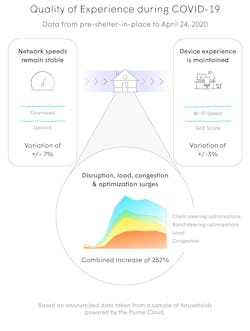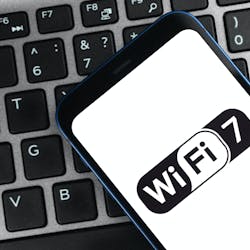Summer is here and households and businesses are gradually reopening their doors. But just 3 months of shelter-in-place was enough to spur an unprecedented and lasting shift in consumer residential behavior and, in particular, working and schooling from home.
This new way of living – our “new norm” – will put even greater emphasis on our digital lifeline: internet connectivity. While those with a close affinity to the smart home industry appreciated that the need for hyper-connected homes was coming, COVID-19 has hastened that reality almost overnight.
Whether your subscribers are bingeing 4K content on Netflix, managing video conference calls, e-learning, shopping, or simply staying connected to various smart devices, the home internet connection has truly become our gateway to the world around us. And although the world is beginning to cautiously open, we should not assume that data consumption will go back to pre-COVID-19 levels of “normal” – at least not anytime soon.
In fact, new research from Accenture found that consumer adoption of digital devices and services–from online shopping to use of virtual assistants–greatly accelerated during the pandemic. Critically, the report found that this new behavior will likely last throughout the next decade.
And it’s not just consumers fueling the change. Google, for example, is giving employees $1,000 allowances to cover work-from-home equipment costs, and Twitter and Square have established policies to continue remote work indefinitely. You can bet others will soon follow suit. All this means more internet-connected devices entering the home, and an increased demand for how those devices are managed and secured by service providers to ensure that they receive the best experience possible, whatever service is being consumed.
So, it’s no surprise that this new way of living is dramatically ramping up the need for connectivity and consumer demand for flawless internet experiences on every device.
As the world enters a new phase, service providers should look at how consumer behaviors have changed–and continue to evolve–during the pandemic to better assess and plan for what’s ahead.
As Plume has gathered data from more than 800 million devices across more than 16 million homes worldwide, we’ve seen firsthand how connected device usage in the home has changed during the crisis and, importantly, how the volume of data and number of devices connected to home WiFi networks has evolved. What our data has shown is that while service providers have been maintaining the quality of service (QoS) to the router or gateway, it really is inside the home where load and congestion has been at peak levels, requiring much higher levels of optimization to maintain a high quality of experience (QoE) on each device.
The Connectivity Crisis
As evidenced by data taken from Plume-powered households across the U.S., by April 17, the number of people working from home across the U.S. had more than doubled, and analogous trends were taking place across the world. While any prognosticator could have foreseen this uptick, what was far more surprising is when people were working. As an unexpected consequence, the 8-hour workday was tossed out the window as people began working longer hours than ever before.
In fact, we found home computer usage during the workday skyrocketed in some regions by 197% since February 17, with the average computer online for more than 5.6 hours between 6 AM to 6 PM. But, notably, people were working later into the evening, with computer usage up by 69% after 6 pm. I know because I’m one of them.
Of course, work from home was just one factor adding to the digital upheaval home networks faced. The use of smartphones and entertainment devices (streaming set-top-boxes, smart TVs, and gaming consoles) also increased, shooting upwards of 152% and 101% increases respectively since February 17. And that was only during the workday, not to mention evenings and weekends.
The New “New Norm” – What’s Ahead?
This can’t last forever, and recently a new trend is beginning to take place. As we begin to “flatten the curve” of COVID-19 transmission, we are also flattening the in-home device usage curve, which dramatically spiked in March but turned to calmer bumps and dips by May and June. In Los Angeles, we saw a 12% drop in device usage from the peaks, which suggested that fewer people were working from home between May 1 and June 1, reaching the second-lowest levels since late April. Cities across the world experienced a similar shift in recent weeks – likely a result of warmer weather and easing of government sanctions. But, while our lives and device usage seem to be stabilizing, we are still experiencing much higher data consumption in the home compared to January.
This newfound stability could simply be the calm inside the eye of the storm. And with uncertainty around our future, device usage and consumer behavior could always dramatically spike again.
Scientists, researchers, and medical professionals around the world have suggested that a second wave of infections might occur as we head into the winter months, and this could mean further restrictions on how we live, and once again, an even greater emphasis on in-home connectivity.
You can imagine what this means for device and WiFi network performance. In fact, I’m willing to bet dollars to doughnuts that anyone reading this has already felt the strain – in fact, you may be experiencing it right now.
Now more than ever, service providers and device manufacturers need to provide a reliable and robust connected home experience into the future. This is not a new requirement, but the recent surge in connected device usage in the home has reinforced the necessity while stress testing existing solutions. And with consumer behavior changing indefinitely, the need to provide a robust, reliable, and secure connection has never been greater.
Subscribers already expect a flawless WiFi experience without interruption, regardless of what device they’re using or where they’re located in the home. And in today’s world digital-first world, nothing could be more pertinent to keeping a subscriber happy.
Todd Grantham is chief marketing officer at Plume. He brings over 20 years of experience in the marketing industry to spearhead the company’s global marketing strategy. Spanning both consumer and business-to-business channels, Todd brings the power of creativity to solve business and communications problems, having worked in senior leadership roles at a number of companies from Fortune 100 to start-ups. His role at Plume touches partner marketing, advertising, creative direction, branding, product marketing and communications.






